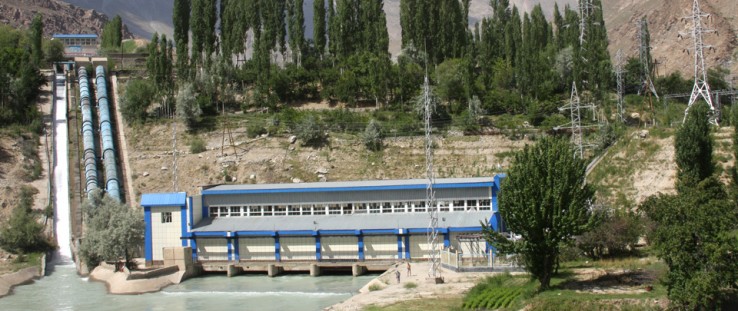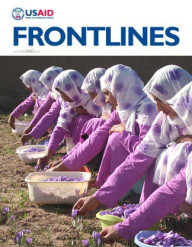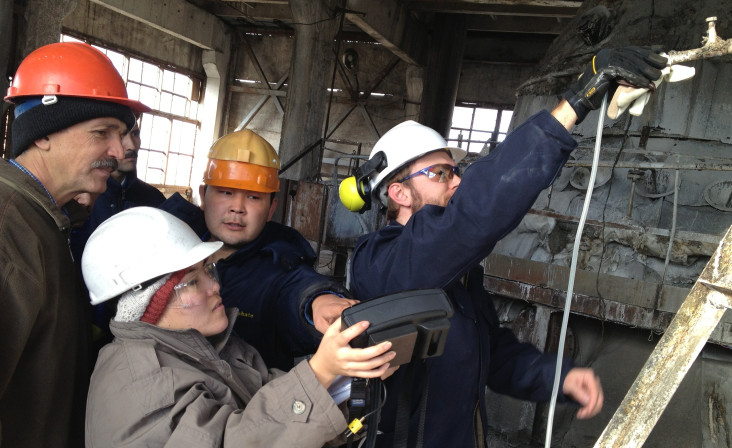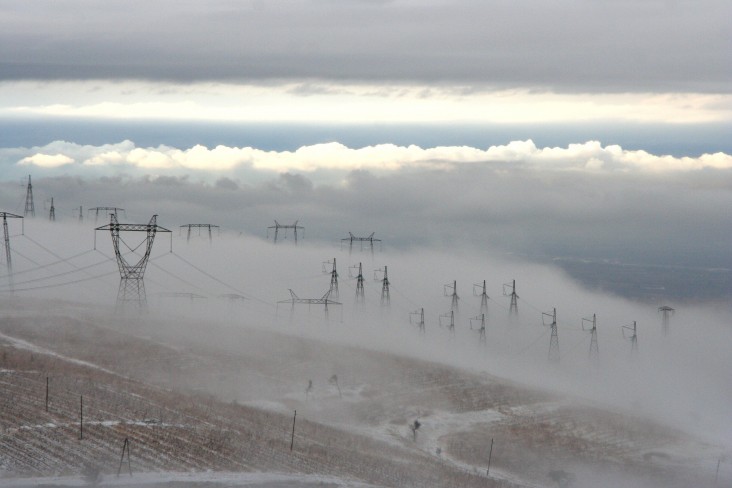 USAID helped the Aga Khan Foundation and Pamir Energy inaugurate newly constructed power transmission lines in Khorugh, Tajikistan, to meet the energy needs of Afghanistan's Badakhshon province.
USAID
USAID helped the Aga Khan Foundation and Pamir Energy inaugurate newly constructed power transmission lines in Khorugh, Tajikistan, to meet the energy needs of Afghanistan's Badakhshon province.
USAID
 USAID helped the Aga Khan Foundation and Pamir Energy inaugurate newly constructed power transmission lines in Khorugh, Tajikistan, to meet the energy needs of Afghanistan's Badakhshon province.
USAID
USAID helped the Aga Khan Foundation and Pamir Energy inaugurate newly constructed power transmission lines in Khorugh, Tajikistan, to meet the energy needs of Afghanistan's Badakhshon province.
USAID
At the intersection of Central Asia and China, the mighty Tien Shan mountains rise abruptly out of the flat steppe. In Kazakh, these towering peaks are known as the “Heavenly Mountains.” To the south, toward their eventual junction with the Himalayas, they take on the name Pamir, or “Roof of the World.” The waters that flow from the Himalayan region alone nourish one-fifth of the world’s population.
During the summer months, as temperatures rise, torrents of snowmelt rush day and night down through lush alpine valleys. Some of the water is captured by dams in the upstream countries of Tajikistan and the Kyrgyz Republic, powering turbines that generate electricity, mostly for local consumption. But the majority is allowed to continue along its downward path through the Syr Darya and Amu Darya river basins, through lands at various times contested by Alexander the Great and Genghis Khan.
While these small, isolated countries have abundant hydropower resources, they lack the domestic demand to make use of their summer surplus, and their options for selling electricity abroad are limited.
Hundreds of miles to the southeast, Pakistan—with its crowded cities and sweltering summer temperatures regularly exceeding 100 degrees Fahrenheit—is losing out on a much-needed new energy source. Chronic summer power shortages force residents to endure the heat without fans or air conditioning. In fact, the news service Reuters estimates that Pakistan currently generates only about half of its peak summer electricity demand. The result is rolling blackouts that can last up to 16 hours in cities and up to 22 hours in rural areas. These disruptions hold back business, hamper learning in schools, endanger hospital patients and interrupt vital government services.
But what if the countries in the region could come together to harness and efficiently allocate this surplus power? That would likely look like CASA-1000, a U.S. Government-backed and World Bank-led project that hopes to install a $1.2 billion, 750-mile electricity transmission grid that would allow the Kyrgyz Republic and Tajikistan to sell hydropower to Afghanistan and Pakistan during the peak summer season. CASA stands for Central Asia South Asia and 1,000 denotes the number of megawatts to be exported to Pakistan, though an additional 300 megawatts is expected to be exported to Afghanistan.
The project has been under consideration since 2006, when leaders of the four countries signed a memorandum of understanding committing them to the project. Now, with nearly all the requisite financing in place, construction could begin as early as next year, meaning power could flow as soon as 2018.
CASA-1000 could have a game-changing impact on the region’s most pressing development and diplomatic challenge: fostering an increased regional interdependence that ties Afghanistan’s future to that of its neighbors. And energy is one of the most logical places to start.
“A more interconnected region can serve as a driver of economic development and as an anchor of peace and security,” said Deputy Secretary of State William J. Burns. “The most important—and perhaps most transformational—step we can take is to build a regional energy market linking existing transmission lines and large supplies of hydropower and natural gas in Central Asia with 1.6 billion energy-hungry consumers in South Asia.”
If successful, the project could be replicated. As Assistant Secretary of State for South and Central Asia Affairs Nisha Biswal believes: “CASA would not only create an energy grid that provides direct benefits to the Tajikistani, Kyrgyzstani, Afghanistani and Pakistani people. It would also establish an important model for energy and economic cooperation between South and Central Asia. By working more closely together, the countries of the region can build the mutual trust needed to address other contentious issues, such as trans-boundary water-sharing, in a more constructive manner.”
The benefits of a regional energy market facilitated by CASA-1000 are manifold. For the Kyrgyz Republic and Tajikistan, which are among the poorest countries in the region, the project would mean much needed revenue. These countries face perennial energy shortages during the winter months when the rivers freeze and heating needs raise the demand for energy. While the export of summer surpluses would not have a direct impact on the winter deficits, the profits could be used to shore up consistent winter energy supply.
Afghanistan would directly benefit from the transit fee—a tax levied on energy that passes through the country—it just negotiated with Pakistan. Afghanistan could earn as much as $56 million annually from this fee plus returns on capital investments once the grid is operational.
CASA-1000 will also provide Afghanistan a valuable source of clean summer energy that could either be re-exported to Pakistan or used to meet emerging domestic needs. These 300 megawatts will complement several other new sources of energy that are slated to come online between 2018 and 2020. These will include an Asian Development Bank-financed 500 kilovolt line connecting Turkmenistan to Afghanistan, and efforts to develop Afghanistan’s Sheberghan gas fields, which are estimated to have vast power-generation potential.
For Pakistan, the project could mean a reliable new source of energy that will be significantly cheaper and cleaner than its current energy sources. Right now the price of electricity in Pakistan—two-thirds of which comes from fossil fuels—averages around 13.2 cents per kilowatt-hour (kWh). On the other hand, the cost of supply in Tajikistan is around 1.5 cents/kWh. Since power would be provided during the peak summer demand, CASA-1000 would increase Pakistan’s power supply precisely when it is needed most.
Perhaps most importantly, the project is expected to provide a vital infrastructure link between Central and South Asia, thereby giving Afghanistan, Pakistan and the countries of Central Asia a shared stake in a stable and prosperous future. At a February 2014 event for the project, Afghan Minister of Economy Abdul Hadi Arghandiwal said, “After years of violence and commercial isolation, regional countries have come to realize [each other’s] economic value.”
A Challenging Opportunity
Officials believe that by increasing the economic interdependence of the countries involved, CASA-1000 will help lay the foundation for regional peace by fundamentally changing incentives for leaders in the region. But, as for any project of this size and ambition, there are challenges.
For one, the four participating countries are not the only ones with a say in the matter. Neighboring Uzbekistan has come out strongly against the project, believing it threatens its water security by opening the door to additional hydropower projects like the proposed Rogun Dam in Tajikistan which, if constructed, would be the tallest in the world. In 2009, Uzbekistan disconnected Tajikistan from the Central Asia Unified Power System in part because of political tensions over this issue.
Another criticism that has been leveled at CASA-1000 is that the surpluses have been exaggerated. A recent Economist article notes how the Kyrgyz Republic has been importing electricity from Tajikistan to conserve water ahead of an anticipated energy shortage this winter. However, though it has indeed been a dry year, the energy shortage is due more to the fact that Uzbekistan shut off gas supplies back in April, shortly after the Russian gas giant Gazprom took over the Kyrgyz gas network, according to USAID officials.
Project feasibility studies have meticulously mapped the historical hydrological data from the region and taken note of the tendency for there to be periods—like this year—of severe dryness. Nevertheless, the studies have also made it quite clear that, even during years when there are minimal water inflows, most of Pakistan’s and Afghanistan’s energy demand at peak hours can still be met.
As it emerges from decades of conflict, Afghanistan’s uncertain future poses an additional challenge. With the pending withdrawal of international forces, security is a key issue for CASA-1000, both during construction of new power grids and after. Threats like landmines, sabotage and theft of equipment must be addressed, and contingency plans have been put in place to mitigate their potential impact. Planning has also involved the local communities living along the project’s proposed route, and community support programs are being readied to help share the project’s benefits with conflict-affected and vulnerable populations in the area.
Nobody ever said that forging lasting links between Afghanistan and its neighbors would be a riskless endeavor. With the military drawdown of U.S. troops underway, development projects such as CASA-1000 rise in importance in fulfilling the goal of regional security. As Deputy Assistant Secretary of State for South and Central Asian Affairs Fatema Sumar has said, “We have a long-term commitment to Afghanistan and Central Asia. It is no longer an Afghanistan military commitment, but it is a political commitment, an economic commitment, a development and diplomatic commitment. It’s telling that the United States is working with its partners to advance opportunities to promote long-term, sustainable economic growth in the region.”
With a new government now in place, there is hope that Afghanistan is on its way to resuming its status as a strategic crossroads connecting Central and South Asia and beyond over a “New Silk Road” (see box below). The traditional ties that bound South and Central Asia with Afghanistan and beyond were largely severed during the 1980s under Soviet occupation. But connections along a New Silk Road are deepening, resulting in expanded regional stability and prosperity. Intraregional trade between Central Asian countries grew fivefold between 2000 and 2008, and the value of intraregional trade in food products, minerals and textiles has since doubled.
Expanding regional energy trade and cooperation is an important next step in this process. CASA-1000 complements other regional energy projects that are currently under development. These include TUTAP, which would link the power grids of Turkmenistan, Uzbekistan and Tajikistan with those of Afghanistan and Pakistan, and TAPI, a proposed natural gas line that would run from Turkmenistan through Afghanistan into Pakistan and then to India. The United States hopes that, as each of these projects comes online and is connected to the larger regional energy grid, Afghanistan may one day be able to fulfill its potential to be a regional energy hub.
Officials from the participant countries seem to agree. “This project is of international importance,” said Osmonbek Artykbaev, former minister of energy and industry of the Kyrgyz Republic. “The demand for electricity in Central and South Asia is growing every year, and CASA-1000 is the first step toward the development of a larger regional energy market.”














Comment
Make a general inquiry or suggest an improvement.